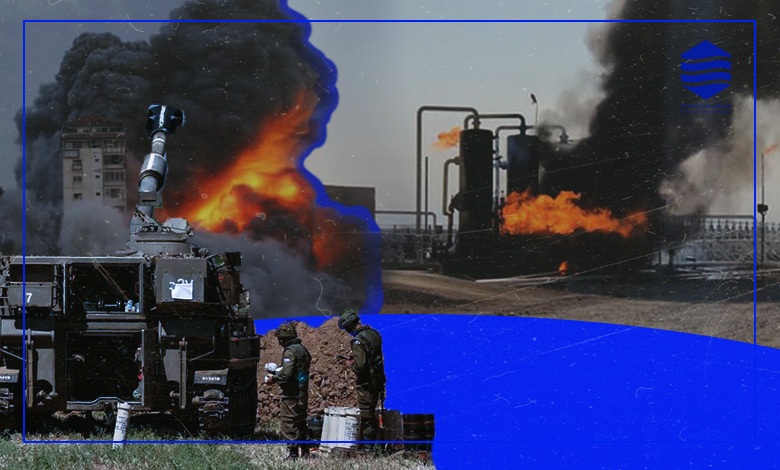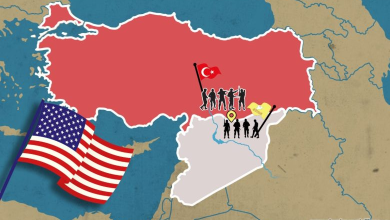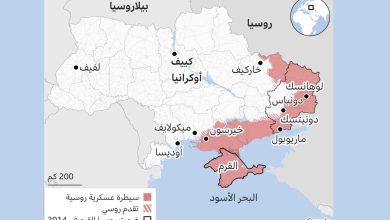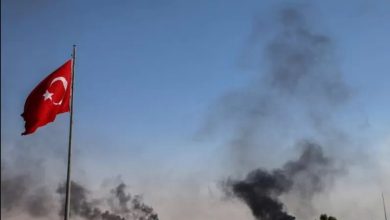
Motives for the Return of Conflict to the Region
The Middle East region is witnessing new developments and conflicts of a different nature, which suggest a change in the existing equations and a shift from the current stagnant phase, marked by implicit threats, to direct and operational threats. Israel has declared that it is in an open state of war with the Hamas movement and has threatened the supporters and backers of the movement after the latter carried out a surprise military operation on Israeli settlements. Additionally, the Syrian regime has escalated its attacks on Idlib following the targeting of the military academy in Homs, which was not claimed by any party, leaving many questions and uncertainties about the party responsible. This is in addition to the Turkish escalation in northern and eastern Syria, which followed Ankara’s operation.
But who is behind these events, and who are the parties benefiting from them?
If we can answer these questions, the plans that coincided with the Turkish government’s bombing of the infrastructure in the cities of northern and eastern Syria may become clear. It is not unlikely that there is a connection between all of these events; the synchronization of these operations at the same time increases the possibility of a joint operations room behind these events. Many indications, seemingly, bear the fingerprints of the “Astana Axis,” and the motives and goals of the parties in this axis can be read as follows:
Turkey:
Anyone monitoring the situation in Turkey can see that the country is experiencing a set of economic and political crises. Despite its attempts to reorient itself towards the West, especially after the recent elections, it has not received a warm welcome from the Western world. It appears that the West has become aware of Turkey’s policy based on duplicity and playing on contradictions, leaving Ankara torn between two axes, the West and the East. This perspective was voiced by the Deputy Head of the European Commission, Margaritis Schinas, on October 13, 2023, when he stated, “Ankara must choose whether it will be with Europe and NATO or with Russia, Iran, Hamas, and Hezbollah.” It seems that Ankara is trying to attract attention and exert pressure on the West, which is why it is searching for any pretext to disrupt the status quo and create tensions to counter Western projects that do not align with its interests in the Middle East. Consequently, the “Al-Aqsa Flood” operation and the attack on the military academy in Homs are in Turkey’s interest, along with recent attacks in the context of its expansionist projects targeting the infrastructure and superstructure in northern and eastern Syria, aiming to destabilize the region and weaken its Autonomous Administration.
There are several reasons that suggest Turkey is behind these events to undermine the stability of the region, including:
-The Turkish-Israeli relations have been fluctuating, despite attempts to mend them in the past two years. It is clear that the contradictions between Israel and Turkey run deeper than what is apparent. The struggle for dominance in the region, which revolves around (Iran-Turkey) and Israel, is at its peak. Turkey is in conflict with Israel, challenging the global system’s “spoiled kid’s” position in the Middle East. Weakening Israel serves Turkey’s interests, as it aims to gain a strategic position within this system.
– The agreement that resulted from the G20 summit in India to establish an economic corridor between India, Gulf states, passing through Israel, and reaching Europe without involving Turkey, which claims that its geographical location should make it a key player, has angered Turkey.
– It seems that Turkey does not want Israel to make agreements with Arab countries, especially regarding recent discussions about normalizing relations with Saudi Arabia. Turkey was the only Muslim country open to Israel in the region, and this uniqueness was a special position for Turkey in the eyes of the global system and Israel. The Arab-Israeli openness diminishes this special status for Turkey.
– Turkey’s embrace of Hamas leaders and the opening of their offices in Istanbul pose an obstacle to the normalization of relations between the two parties. This is especially significant given that Hamas leaders have stated on multiple occasions that their relationship with Turkey continues.
– The Turkish-Israeli conflict over natural gas fields in the Mediterranean.
– The presence of the United States in the region is a constant source of concern and irritation for the Turkish government. Observers of the Turkish media are well aware of this irritation. Because this presence is an obstacle to its expansionist projects in the region. The fierce fighting that Turkey is engaged in against the Autonomous Administration carries within it an element of the hidden confrontation with the international coalition against ISIS, with several aspects, including: Combating the evolving Kurdish project in the area where the US-led coalition forces are present on one hand and pressuring these forces, which keep Turkey out of its plans, on the other. Erdogan’s recent statements regarding the American presence in Syria and the region are nothing but a result of his great frustration. Turkey sees the reinforcement and significant presence of these forces as a threat, especially after the American forces shot down its drone on October 5, 2023. This was not an ordinary event but a significant indicator, especially considering that they are “NATO allies.” Furthermore, the decision by the US administration to extend the state of emergency in Syria on October 12 adds to the Turkish government’s concerns and anxieties. Especially since the justifications for the extension now include, for the first time, the recent Turkish airstrikes in northern and eastern Syria.
Iran:
The global system is increasingly isolating Iran, in addition to the economic sanctions that are burdening the government.
The conflict in the Caucasus (Karabakh) did not serve Iran’s interests. It resulted in the necessity of opening the “Zengezur Corridor” between Armenia and Azerbaijan to transport oil and gas from Turkmenistan and Azerbaijan through Turkey to Europe. This contradicted Iran’s plans to export its oil and gas to Europe through Armenia. Iran also views the opening of this corridor as an existential threat and calls it the “Zionist corridor” because it would allow the expansion of Israel, which has a presence in Azerbaijan, as well as NATO, into the Caspian Sea region, thereby encroaching on Iran. This has led Iran to explicitly reject the opening of this corridor. Furthermore, opening this corridor would increase the likelihood of a conflict between Iran and Azerbaijan, which is an ally of Turkey, and subsequently, the potential for escalating tensions between Turkey and Iran.
The “economic corridor” between India and Europe, announced by the Saudi Crown Prince Mohammed bin Salman during the G20 summit in India, tightens the pressure on Iran. The new route is supposed to pass through the Arabian Gulf, coming from India to the United Arab Emirates, then through the territories of Saudi Arabia, Jordan, and Israel before reaching Europe. The project will also include a new underwater cable and energy infrastructure, according to the Financial Times. This corridor, which ignores Iran and Turkey, will further encircle Iran and increase its isolation.
On the other hand, preparations for Saudi-Israeli normalization were a major concern for Iran, keeping it awake at night. This normalization damages Iranian interests in the region and further isolates Iran politically. When added to the normalization processes that have occurred and are occurring between Arab countries and Israel, it ultimately poses a significant threat to Iranian interests and tightens the siege on its militias and tools in the region. Considering the rapid and significant events taking place in the region, it is easy to cast doubts about Iran and its role in the “Joint Operations Room” and accuse it of involvement in orchestrating these events.
The ongoing Israeli airstrikes on Iranian sites in Syria pose an existential threat to Iran and put Tel Aviv in an offensive position. Therefore, the Hamas operation –one of Iran’s arms– at this time serves as a preemptive move and a strike against Israel, relying on the element of surprise in an attempt to drag it into an unforeseen war, keeping Israel on the defensive. It can be said that this strike will strip Iran of one of its key assets, which it uses to control the initiative. Iran’s goal behind this operation is to convey a message emphasizing the necessity for the West and Israel to take into account Iran’s presence in the region. Despite Iran’s official denial of its involvement in the “Al-Aqsa Flood” operation, it has shown full support for this operation. This was evident in the statement by Ali Akbar Velayati, the advisor to Iran’s Supreme Leader, who said, “I congratulate you on this great strategic victory, which serves as a serious warning to all compromisers in the region, and we believe that the increasing victories will continue until the elimination of this criminal regime.”
Russia:
There is no doubt that the recent events in the region are directly in the interest of Russia, which is now in its second year of the war in Ukraine. The Russian stance towards recent Hamas attacks has been noteworthy, as it has expressed concern about the situation. At the same time, Russia has not shown any clear position regarding Turkey’s recent attacks in northeastern Syria but has, in fact, appeared to support these attacks. The direct statement by Russian President Vladimir Putin is a clear indication of giving Turkey the green light for the military operation. He mentioned that Moscow is ready to mediate between the Syrian government and the Syrian Democratic Forces in the northeast of the country, according to the Russian news agency TASS.
The emergence of new tension points in the region is in Russia’s favor, as it believes it can divert the United States and Europe’s attention to them, thereby reducing pressure on Russia in its war in Ukraine. Furthermore, the “Economic Corridor” project poses a significant threat to Russian interests in the Middle East, along with the deliberate and substantial disregard for Russia and China, as well as Iran and Turkey’s involvement in it, which places them under suspicion and accusation of being part of the “Joint Operations Room” mentioned earlier.
In conclusion, the situation in the region has become more complicated. Iran, Turkey, Russia, and the Syrian regime have found themselves in need of recycling the crisis and initiating new wars to justify their continued presence in Syria and to obstruct any political solutions, especially those proposed by UN resolutions.
Therefore, all recent events, starting from the Turkish offensive in northern and eastern Syria, passing through the attack on the Military Academy in Homs, and culminating in the Hamas operation against Israel, were likely prepared in the same kitchen, which is probably the “Axis of Astana” kitchen. This comes after the parties of this axis have become aware that the region is heading towards a new political map that will not serve their interests and goals if things settle down. This is the common concern and denominator among the countries of this axis, and as such, they will continue to sow chaos and tension as long as they seek alternative solutions that suit them.
In addition, it appears that the region is on the verge of significant transformations, as indicated by the statements of the Israeli ambassador to the United Nations, Gilad Erdan, who compared Hamas’ attack to the events of “September 11,” those events that altered the balance of power in the Middle East significantly after the United States entered Afghanistan and Iraq. What reinforces this hypothesis is the movement of the United States’ military fleet and both Washington and Tel Aviv describing Hamas as “ISIS.” All of these events foreshadow a dramatic development in the situation and increase concerns about the widening circle of war and conflict in the region, putting it on the brink of profound changes.





